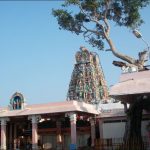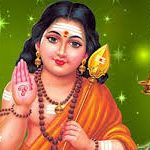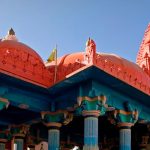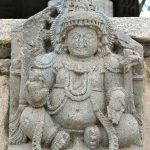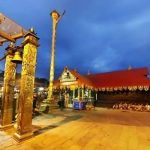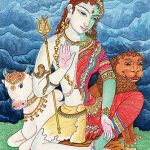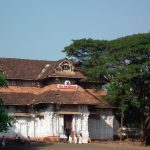The Thiruchendur Murugan Temple is an ancient temple that is one of the six abodes or Arupadaiveddugal of the Lord Murugan. It is located in Tuticorin district on the shores of the Bay of Bengal. The location of the temple is the place where Lord Muruga (Karthikeya) battled a demon and emerged victoriously. The 2004 tsunami did not affect the temple even though it is right on the seashore.
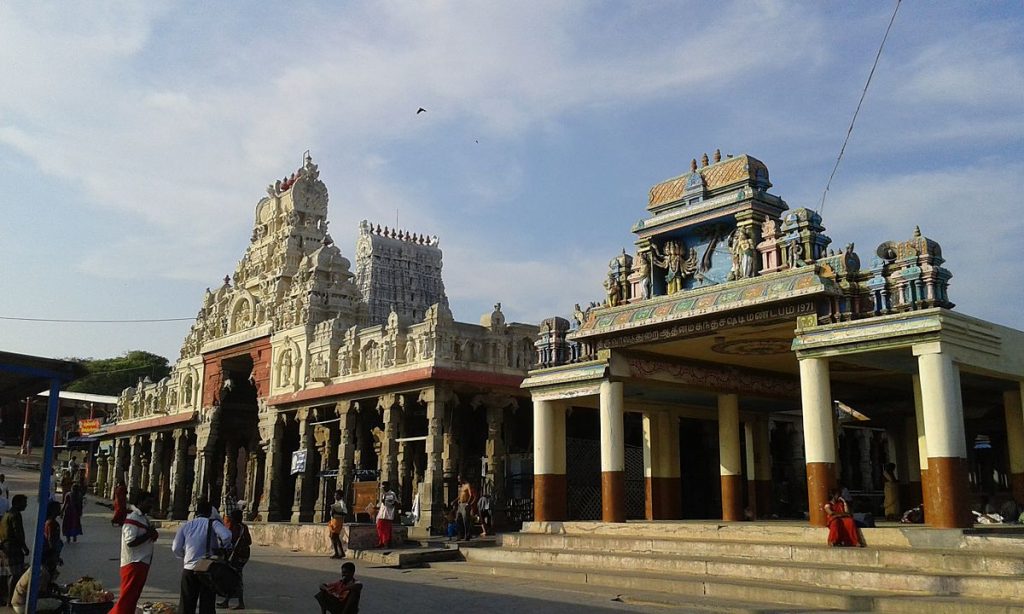
Image Source
Arupadaiveddugal
Tamil devotional texts state that Lord Muruga has six chosen places that he prefers more than others. These six places are Thirumurugarruppadai or Arupadaiveedugal. Of these six favourite places, the Tiruchendur Murugan Temple is the second favourite. Lord Murugan favours mountain terrain for his temples. This temple is unique among the others because it is on the seashore. The other abodes are Subramanya Swamy Temple at Thiruparankunram, Dandayuthapani Swamy Temple at Palani, Swaminatha Swamy Temple at Swamimalai, Subramanya Swamy Temple at Thiruthani and Subramanya Swamy Temple at Pazhamudircholai.
Legend Skanda Purana – The Great Battle
The Divine Baby
The Shivarahasya Khanda in the Skanda Purana tells the story of Tiruchendur. The Devas were losing their battle against the Asura Surapatuma. They went to Lord Shiva and asked him for help. Lord Shiva answered their prayers with six sparks of fire from his third eye. Agni the God of fire received the sparks and he put them into the river Ganges. They then flowed to the Saravana lake in the Himalayas and became six babies. The Kritikkas suckled the babies and Goddess Parvathi made them into one baby. The divine child was then known as Arumuga which means six faces. He was very beautiful and was also called Skanda, Shadanana and Shanmuga. Since he was the warrior of the Gods he was also Kartikeya.
Lord Murugan Camps At Tiruchendur
Lord Muruga went to the south and camped at Tiruchendur. He wanted to worship Lord Shiva and the celestial architect Mayan made him a shrine. Lord Murugan then went to battle with the Asuras. For five days the sons and brothers of the Asura Surapatuma battled Lord Muruga on land, air and sea. On the sixth day, only Surapatuma was left standing. Lord Murugan gave the Asura his Vishwaroopa Darshan. Though Surapatuma realised who he was fighting his pride did not allow him to accept defeat.
Lord Murugan rode upon Indra who was in the form of a peacock and with his lance or Vel sought the Asura in the ocean. Surapatuma was in his fortress which was on an island in the ocean. He took the form of a frightful mango tree and attacked Lord Murugan. The Vel of Lord Murugan split the tree into two. One half became a peacock and the other became a rooster. The peacock attacked Indra but Lord Murugan forgave him and replaced Indra with the peacock as an act of forgiveness. He put the rooster on his banner. He returned to Tiruchendur and worshipped again at the temple that Mayan had built.
The temple was formed from a red sandstone cliff. The Pandyas and the Cheras expanded the temple. As time went by the red sandstone that the original temple was made from began to wear away. The three Tirupannis then renovated and reconstructed the entire structure in black granite. The Gopuram is large enough to be visible for miles out at sea.
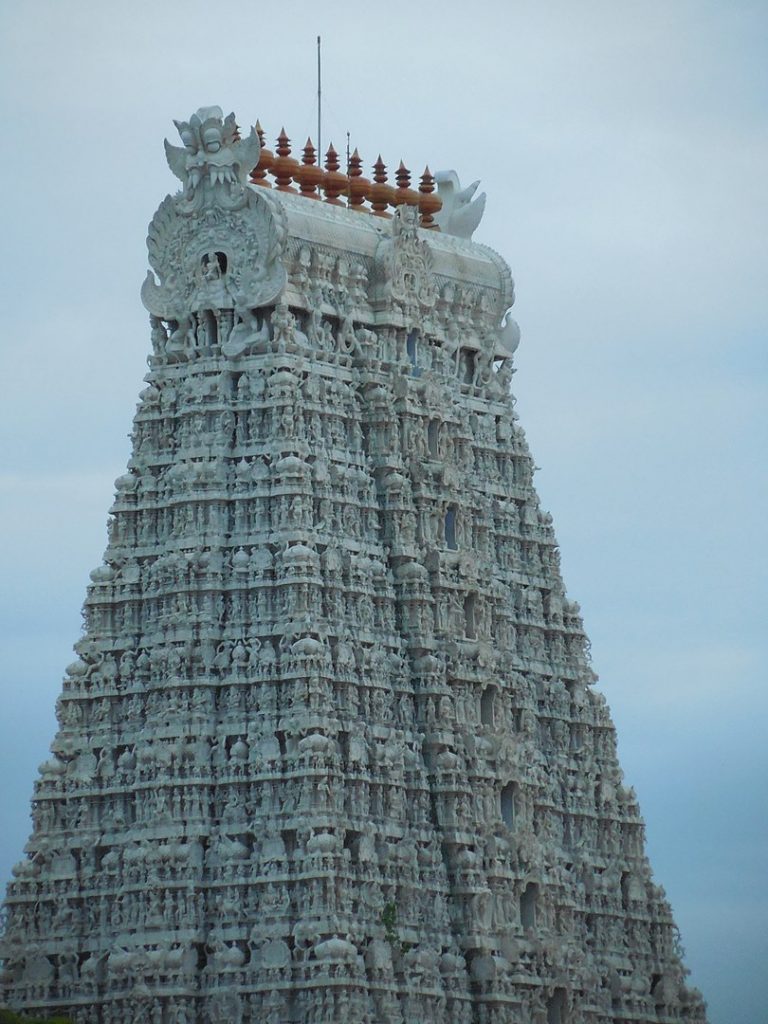
Image Source
Vaippu Sthalam
The Tamil saint Nayanar Appar sang of the Tiruchendur Murugan Temple as one of the Vaippu Sthalams.
Adi Shankaracharya
Adi Shankara was also one of the greats who visited Thiruchendur. When he prayed to the deity of Kumara (Muruga) here, the entire Subramanya Bhujanga Stotram flowed out of his lips spontaneously. Such was the power of Lord Kartikeya’s blessings.
Architecture
The Thiruchendur Murugan Temple is near the seashore. The Gopuram is 9 storeys tall. The main entrance of the temple is south facing. There are two Prakarams in the temple. The first Prakaram has rows of Yalis. The sanctum is in a cave and portrays Lord Murugan as a child. The deity is granite. The temple has a well called the Naazhi Kinaru. It is fed by a sacred spring and devotees bathe here before entering the temple.
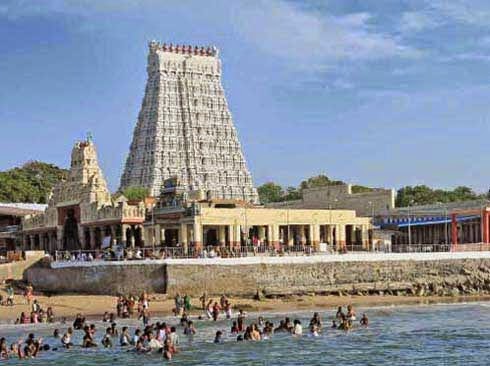
Builders – Temple Tirupannis
Three Swamis or Thirupannis renovated the Thiruchendur Murugan Temple. They had no worldly possessions but dedicated their entire lives and efforts to renovating and rebuilding the temple. The three Tirupannis or temple builders have sculptures depicting them in the temple. Their Samadhis are also near the temple.
Mauna Swami
The first Tirupanni was called Mauna Swami as he maintained a vow of silence. When he saw that the original red sandstone structure of the temple was badly worn out he dedicated his life to the renovation and rebuilding of the temple in 1868. He communicated with the builders by writing on the sand. He would give Vibhuti (holy ash) to the worshippers at the temple and in turn, earned donations for the Tiruppani funds. The Swami removed the sand dunes that were obscuring the Western Gopuram of the temple and also gave it an oil coating.
Kasi Swami
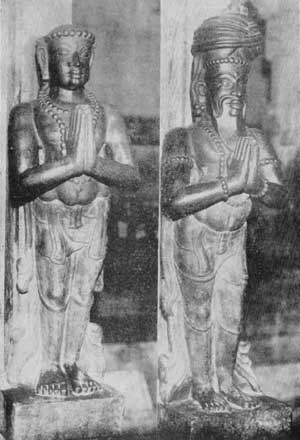
Image Source
Mauna Swami then started on the work to construct the Eastern Gopuram. In 1872 another ascetic from Kasi joined him. He was known as Kasi Swami. He collected grain and funds and helped with the work. Mauna Swami left Kasi Swami in charge of the work and then left to Ceylon by country boat to raise funds. The sum was not sufficient for the entire Gopuram and he started a Hundial for collections at the western door and also collected a handful of rice from every house on a daily basis.
Second Gopuram
The Mauna Swami broke his vow of silence after the Gopuram was completed. He started the renovation of the great western Gopuram in 1877.
Temple Cars
At this time a fire destroyed the Thiruchendur Murugan Temple cars and burnt them to ashes. The Swami decided to replace them and approached the Maharaja of Travancore for help. The Maharaja obliged him with timber and two huge poles for the temple Dwajasthambas. The Swami used the wood to build the temple cars and the Dhwajasthambas. The Kasi Swami obtained lands in the area and plated Illupai and other trees there. It is now the Illupai Thoppu. The Swami also constructed a Vasanta Mandapam. The Swami then planted a grove of Illupai trees around it. This grove is still very beautiful to behold. Mauna Sami then constructed a Shanmuka Vilasa.
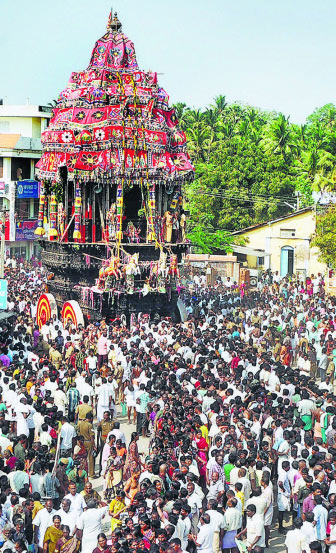
Image Source
Armukha Swami
After the passing of the first two Swamis, Armukha Swami took over the work in 1910. He then replaced the pillars and renovated the rest of the temple. He also executed the work for the Garbha Griha, Ardha Mandapa, Valli Shrine, Teyvayanai Shrines, the flooring as well as the temple walls.
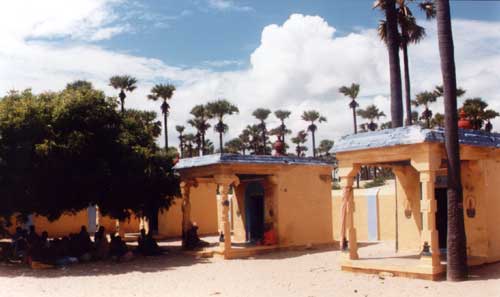
Image Source
Teerthas
The Sthala Purana or the texts of the temple lists nine Theerthas or bathing places in the temple. One of the Teerthas is the sea. Lord Shiva cut off one of the heads of Lord Brahma. A bath here restored the head. Angasundari was a Pandya princess who had the face of a horse. She bathed in the Vathanarambha Teertha and became beautiful.
There are also 24 different spots on the beach marked by stone pillars that name the Teertha spots.
Vadamalaiappa Pillayya And Kattabomma Nayakkar
Kattabomma Nayakkar was a powerful Poligar and devotee of Lord Muruga. On the seventh day of the temple festival, the Lord Thiruchendur Murugan was taken to the Pillayan Mantapa. However, Kattabomma Nayakkar built another Mantapa. He then arranged for the Lord to be taken to the new Mantapa. Vadamalaiappa Pillayyan did not want to go against the Nayakars wishes.
But on the seventh day when the procession started from the temple, there was a strong cyclonic wind. The wind tossed the procession bearers here and there. Finally, after the cyclone had passed the group found themselves in the Pillayan Mantapa. Kattabomma Nayakkar realised his folly and paid his respects to Vadamalaiappa Pillayya as the true devotee of Lord Murugan. This incident is retold in Tamil poetry as well as the Thiruchendur Murugan images in the temple.
Dutch Occupation Of The Thiruchendur Temple
The area where the temple is located was on the seashore. In 1648 AD when there was a war between the Dutch and Portuguese, the Dutch occupied the temple. When they vacated the temple they tried unsuccessfully to damage it. Finally, in the process of plundering, they took the idol with them and left by sea. They then faced a huge storm. They realised that they had committed a mistake by stealing the idol away and so dropped it into the sea after which the storm subsided.
Vadamalaiappa Pillayya then ordered an idol to replace the original. Lord Murugan appeared to Vadamalaiappa Pillayya in a dream and revealed the location of the idol. His dream informed him that the idol would be found at the spot in the ocean where there was one floating lemon and also a kite circling overhead. He then went to the place with fishermen, and retrieved the Thiruchendur Murugan idol! Paintings in the temple depict the incidents.

Thiruchendur Murugan Temple Car Deities
Image Source
Festivals
Devotees recount and reenact the legends of Lord Murugan during the festival in the month of Aipassi. the festival concludes on the day of Skanda Shashti. Devotees also read the Kanda Puranam in their homes during this festival.




